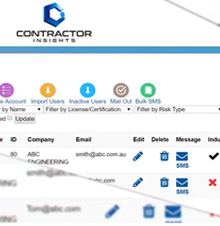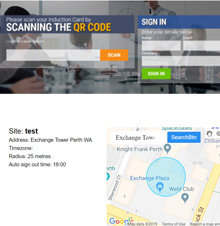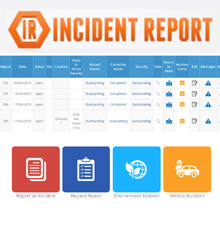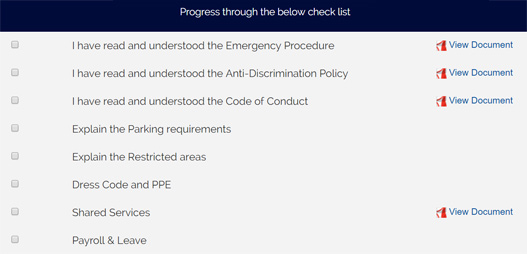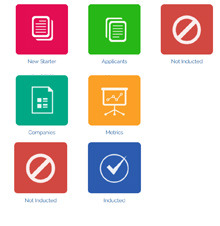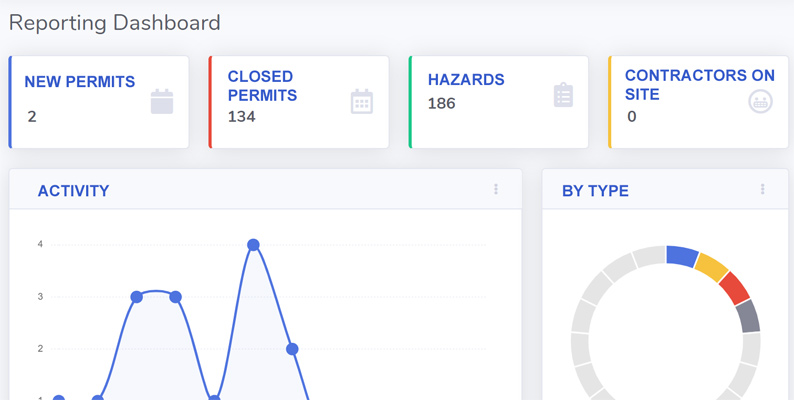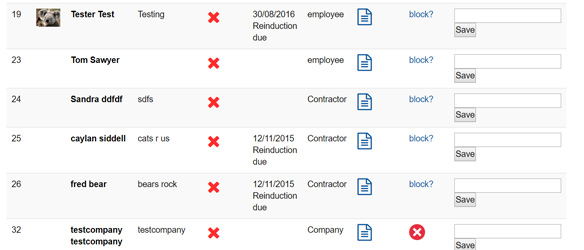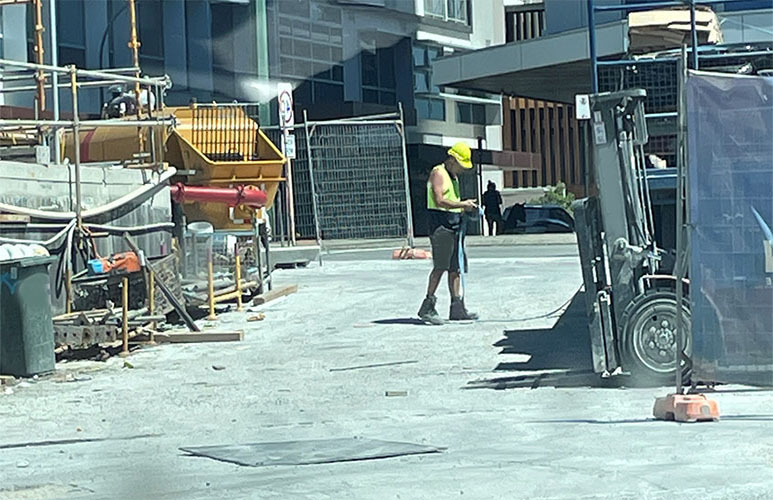Subcontractor Management Software
- Managing Subcontractors
Online Induction >> Subcontractor Management Software
Published 29/08/2025
 Subcontractor management is a major part of a contractor management system where commonly a facility manager, compliance manager, safety manager or project manager manages the engagement, compliance, insurance and license checks, safety, job tasks and activities through to job completion and exit of subcontractors on their site or project.
This often involves inducting subcontractors, prequalification, insurance and license checks and approvals, safety and performance review and feedback.
If you manage subcontractors, it's important that they are inducted, are compliant, tracked on site and properly managed especially around their certifications, licenses and insurances.
Subcontractor management is a major part of a contractor management system where commonly a facility manager, compliance manager, safety manager or project manager manages the engagement, compliance, insurance and license checks, safety, job tasks and activities through to job completion and exit of subcontractors on their site or project.
This often involves inducting subcontractors, prequalification, insurance and license checks and approvals, safety and performance review and feedback.
If you manage subcontractors, it's important that they are inducted, are compliant, tracked on site and properly managed especially around their certifications, licenses and insurances.
Presenting the step by step best practice options for subcontractor management and how to keep on top of your subcontractors with tools, apps and subcontractor software setup and implement your subcontractor management plan.
Prequalify Subcontractors
 All subcontractors should go through a prequalification process to ensure they are suitable to be on site and have the appropriate insurances, certifications and licenses in place as well as the relevant systems and procedures to ensure they are going to work safely and appropriate to their risk level for the nature of work being undertaken.
This step evaluates the actual systems, processes, procedures, insurances, training and safety history that the subcontractor has in place. This allows an organisation (a head contractor or a client organisation being serviced) to evaluate and rate their contractors on these areas to identify if they are a compliance risk or a future workplace risk (i.e. they don't have the systems and processes in place).
This process might classify a subcontractor by risk level (i.e. nature of work is high risk) and even prompt them to provide additional materials and responses based on the nature of their work.
All subcontractors should go through a prequalification process to ensure they are suitable to be on site and have the appropriate insurances, certifications and licenses in place as well as the relevant systems and procedures to ensure they are going to work safely and appropriate to their risk level for the nature of work being undertaken.
This step evaluates the actual systems, processes, procedures, insurances, training and safety history that the subcontractor has in place. This allows an organisation (a head contractor or a client organisation being serviced) to evaluate and rate their contractors on these areas to identify if they are a compliance risk or a future workplace risk (i.e. they don't have the systems and processes in place).
This process might classify a subcontractor by risk level (i.e. nature of work is high risk) and even prompt them to provide additional materials and responses based on the nature of their work.
A part of this process might be to ensure all subcontractors have gone through a contractor prequalification as part of your overall Contractor Management System
Subcontractor Management Plan
Establishing a subcontractor management plan is a core guiding document behind how your organisation will engage and manage subcontractors on site. It typically includes:- Roles and Responsibilities
- Project Management
- Training
- Quality Assurance
- Management of Change
- Management Practices
- Safety
- Permit to work
- Progress Reporting
- Contractor Issue Management
- Review Practices
- Acceptance process
How to ensure Subcontractors are Compliant
One of the big struggles with subcontractor management is ensuring that all subcontractors go through the same processes you have for your head contractors. They might go through your extensive contractor management system but how do you ensure that any subcontractors they use do too?Commonly you'll start by establishing your contractor induction and contractor prequalification process to create a flywheel effect where each contractor that is prequalified, will in turn prequalify their contractors and so on ensuring that all subcontractors are captured in this process. As part of this workflow:
- capture all insurances and evidence of training from subcontractors
- verify these materials are correct and valid
- induct subcontractors on safe work procedures, hazards, risks, preparing them for their job task or activity and first day on site
- issue an induction card to subcontractors
Tracking contractors on site has a range of benefits for both the employer and employee. By tracking contractors on site, employers have an accurate idea of who is present during any given time period and can ensure that everyone is accounted for in case of any emergencies or accidents that may occur. Additionally, this can help to keep projects to their desired timeline as it allows employers to quickly identify where resources are needed most. Furthermore, ensuring the safety of contractors by having an effective system in place to track them ensures peace of mind from all those involved with the project a valuable asset for successful completion.
Start by inducting your subcontractors
 All subcontractors need to be inducted before they start working on site.
All subcontractors need to be inducted before they start working on site.
Before each subcontractor is engaged to work on site or begin their job, they need to do a full induction on that specific worksite covering important safety and site hazards as well as ensuring they are properly ensured and approved for working on site.
Every individual subcontractor needs to be compliant, they should also be given the tools to report and be aware of hazards and incidents that occur in the workplace while working in their role. Inductions should be based on risk level. High risk work should be a more comprehensive high risk induction versus low risk subcontractors who might do a smaller low risk induction.
Managing subcontractor documentation and compliance
A big part of subcontractor management is the management of all documentation, materials, licenses, certifications and overall compliance of subcontractors. This might include managing JSA's (Job Safety Analysis) or Safe Work Method Statements. Other areas managed might also include subcontractors daily sign in sheet or Daily Prestarts.It's important for businesses of all sizes to understand the documents that need to be in place when working with subcontractors. The implications of not following the correct procedures or having inaccurate paperwork can cause significant delays or financial losses down the line. To help you get started, here are some common documents that should be included in your subcontractor agreement: a signed contract, proof of valid insurance premiums, proof of workers compensation coverage, a copy of their credentials and/or certification where applicable, any relevant project-related data or reports, and an agreed timeline of payment terms and milestones.
By taking the time to review, prepare and include these standard pieces of paperwork during the onboarding process for new subcontractors, you can save yourself valuable time, protect your investments and ensure that everyone involved is playing by the same rules. We hope this blog post has been helpful in understanding what common documents are required for subcontractor documentation and compliance.
Know who subcontracts to a head contractor
When managing so many contractors, understanding who subcontracts to who can be overwhelming. Are there any breaks in the compliance chain when it comes to contractors and their subcontractors? Does that break in the chain due to a non compliance result in an issue for your head contractor? This is where mappying contractor and subcontractor relationships kicks in as a major subcontractor management piece in having oversight of contractors and their relationships and compliance status.You may have an extensive prequalification process for your contractors but not your subcontractors. Who is subcontracting to your contractors?
A contractor may be approved to work on site but what about their subcontractors? using a proper subcontractor management process you can also ensure all subcontractors have gone through an extensive prequalification process and approval process. Know who all the subcontractors are and who they subcontract to.
Subcontractor Org Chart
Part of mapping subcontractor relationships and who subcontracts to who is via a subcontractor org chart. You can fully map out all subcontractors with a proper subcontractor org chart knowing which subcontractors are contracting to which principle contractors. Fully map all the relationships together.Subcontractor Performance Management
For long term subcontractor relationships, set up proper review processes to check and review the safety performance of your subcontractors. Should they remain a preferred and approved subcontractor 12 months on?- rate subcontractors based on their safety and risk history
- rate subcontractors based on the number of incidents they have had
- rate subcontractors on their job task or activity
- get feedback from site about the subcontractor
- get feedback from the head contractor that engaged them
Should they remain a preferred and approved contractor?
Track subcontractors on site, checked in and out, where are they now?
Track all subcontractors on site! who is on site right now, for how long, when did they check in and check out? how many sign ins has the subcontractor had today and in the last month?Using our subcontractor management software you can properly track all subcontractor movements!
 Make sure subcontractors are inducted
Make sure subcontractors are inducted Map subcontractors to which contractors they contract to
Map subcontractors to which contractors they contract to  Who are all the subcontractors?
Who are all the subcontractors? Make sure subcontractors are approved and prequalified, do you want them subcontracting?
Make sure subcontractors are approved and prequalified, do you want them subcontracting? Ensure subcontractors are compliant and ensured
Ensure subcontractors are compliant and ensured Track subcontractor movements on site, check in and check out times, who is available right now
Track subcontractor movements on site, check in and check out times, who is available right now Review subcontractor performance
Review subcontractor performanceBest Practice Subcontractor Management Setup
A best practice subcontractor management setup often includes having clear, detailed contracts that spell out the scope of work, payment terms, and any other relevant details. This includes having regular meetings to review progress, identify any issues, and discuss any changes that may be needed and a comprehensive contractor onboarding and training setup with policies and procedures to ensure that subcontractors are familiar with the company's important policies and procedures. This leads to having a system to monitor and track progress, including regular updates and progress reports which might include a process for resolving disputes quickly and professionally, evaluating subcontractors performance, including metrics and feedback, evaluating subcontractors' safety practices and compliance with local regulations, tracking they have appropriate insurance coverage for all subcontractors, managing change orders and other unexpected costs and for managing subcontractor termination and offboarding.Emerging Subcontractor Management Challenges for 2026
There are a number of common emerging subcontractor management challenges being faced by organisations around:- Lack of Visibility Into Subcontractor Performance where it can be difficult to ensure that subcontractors are meeting deadlines and providing quality work.
- Poor Communication between the contractor and subcontractor can lead to delays, misunderstandings, and ultimately, cost overruns.
- Unclear Scope of Work where it can be difficult for a subcontractor to understand the project's objectives and deliverables.
- Inadequate Risk Management where subcontractors may be exposed to financial and legal risks that could have been avoided with proper procedures.
This is where a best practice subcontractor management system helps organisations tackle these issues with a streamlined and autonomous approach.




